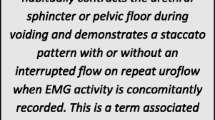Abstract
Voiding parameter values measured with ambulatory urodynamic monitoring (AM) are generally found to be different from those measured with conventional cystometry (CMG). The reason for this is unclear, but might be related to differences in the voided volume. To verify this hypothesis, we compared voidings from female patients at an initial bladder volume that was close to the modal volume (that is, the volume most often voided by the patient as derived from frequency/volume charts) with voidings at maximum cystometric capacity during a routine video urodynamic examination. A first group of 35 patients voided at the modal volume before they did at capacity. The order was reversed in a second group of 12 patients. The dependence of the voiding parameters on the voided volume and the order of the measurements were examined. It was found that the maximum flow rate depended significantly on the voided volume, but the associated detrusor pressure did not. Urethral resistance and bladder contraction strength were not volume dependent either. It was concluded that the differences between AM and CMG cannot be explained from possible differences in the voided volume.
Similar content being viewed by others
Author information
Authors and Affiliations
Additional information
Received: 23 August 1999 / Accepted: 16 December 1999
Rights and permissions
About this article
Cite this article
Groen, J., van Mastrigt, R. & Bosch, R. Factors causing differences in voiding parameters between conventional and ambulatory urodynamics. Urological Research 28, 128–131 (2000). https://doi.org/10.1007/s002400050150
Issue Date:
DOI: https://doi.org/10.1007/s002400050150




